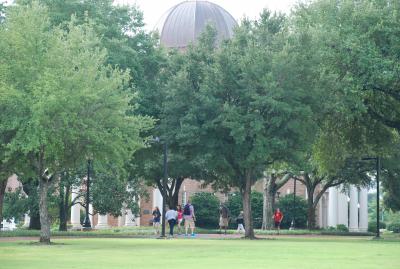Campus Tree Inventory to Profile Environmental, Economic Values
Wed, 09/14/2011 - 02:33pm | By: David Tisdale

A University of Southern Mississippi professor and his students hope their inventory of trees on the Hattiesburg campus will reveal their full environmental and economic value and be a key resource for their management and preservation.
Kenneth Rhinehart, an adjunct professor of environmental science at the university, believes Southern Miss has great potential to be a leader in urban forestry by examining and enhancing its tree population, and is a viable candidate for a “Tree Campus USA” designation from the Arbor Day Foundation. The Tree Campus USA designation recognizes college and universities that meet certain benchmarks focused on the on promotion of healthy trees and student involvement in their management and care.
The current inventory of the historic district of the university may be downloaded from Google Earth (online visit http://www.professorkr.com/maps).
“We're a state gifted with a precious resource, and our campus is a fine example of that with a wonderful assortment of trees that enhance it aesthetically, environmentally and economically,” Rhinehart said.
Along with students in his Environmental Science (ESC 302) class, Rhinehart began the inventory in spring 2010 with the trees in the Hattiesburg campus' historic district. The project is nearly 95 percent complete as it expands to cover the rest of the campus, with the help of free computer software provided by Google Earth and by the U.S. Forest Service.
Rhinehart says the Hattiesburg campus has approximately 60 species of trees. Among the most populous are live oaks, which line many of its streets. One of the rarest is the Winged Elm, with only one that makes Southern Miss its home.
His favorite? The Longleaf Pine. “It's what we used to build the university, and it's the signature tree of our area,” he said.
Rhinehart is serving as a member of the Hattiesburg campus' Tree Management Task Force, which serves as a resource for advisement and recommendation regarding the addition, removal and management of the university's tree population.
In addition to Rhinehart, its members include Southern Miss Associate Professor of Biology Dr. Mike Davis; Physical Plant Safety Director Rodger Jackson; Mark Anderson, a Mississippi Registered Forester; Loren Erickson, a forester with the city of Hattiesburg; and landscape architect Russ Bryan.
“We appreciate the work of Professor Rhinehart and his students in developing this
tree inventory, which will serve as a tremendous asset to the university and this
committee as we work to better preserve and manage the impressive tree population
that is such a signature of the Hattiesburg campus,” said Southern Miss Physical Plant
Director Dr. Chris Crenshaw, who leads the task force.
Sophie McNeil of Madison, who graduated from Southern Miss in May 2010 with a degree in journalism, took Rhinehart's science class in the spring of 2010. As an EcoEagle representative for the Southern Miss Office of Sustainability, she wanted to be more educated and well-rounded about environmental issues she was passionate about.
“When I learned of his second environmental science class offered in the spring working with tagging coordinates of trees, I knew it was my chance to get intimately involved environmentally on USM's campus,” said McNeil, who now works as marketing coordinator for the Jackson (Miss.) Convention and Visitors Bureau.
“The class was one of my favorites because the campus was the classroom. It was a unique experience to see our buildings and campus landscaping in a new way,” she said. “The trees and atmosphere on campus were part of what initially drew me to attend USM, so to come back to that at the end of my senior year was very special.”
Reforestation benefits rural, urban areas
Insufficient demand for forest products in the state has had the ironic consequence of loss of our forests, Rhinehart said. Although Mississippi is noted for its rich woodland resources and timber industry, it is falling prey to failure to reforest much of those woodlands after they have been harvested because of shortsighted thinking and urban sprawl.
“Mississippi needs to emphasize the resource for which we are so gifted,” he said. “Even during this recession, economics associated with the state's forests is a multi-billion dollar industry. With smart management, we can increase this asset.”
Rhinehart said the advantages of reforestation include:
· Absorption of carbon dioxide
· Minimization flooding due to absorption of moisture by trees
· Sustainment of wildlife
· Add value to property
· Trees are sources of medicine
In addition, healthy forests contribute to proper rainfall, moderate temperatures, storm intensity reduction, erosion control, flood control, wildlife, and beauty to name just a few environmental attributes. Rhinehart also noted that highway departments across the country are planting trees on portions of grassy right-of-ways to reduce costs and manpower associated with their maintenance.
Rhinehart said urban forestry is also growing in importance. “Cities are discovering that trees contribute much more than just aesthetics. Climate control, noise control, and pollution control are aided by adding trees to a city,” he said.
His hope is that Southern Miss will be a leader in turning the tide back toward reforestation and preservation of an icon of the state's natural beauty. “Every cause needs a champion, and we can be that champion. Southern Miss can lead the way,” Rhinehart said.
For more information about the Arbor Day Foundation's Tree Campus USA program, online visit http://www.arborday.org/programs/treecampususa/